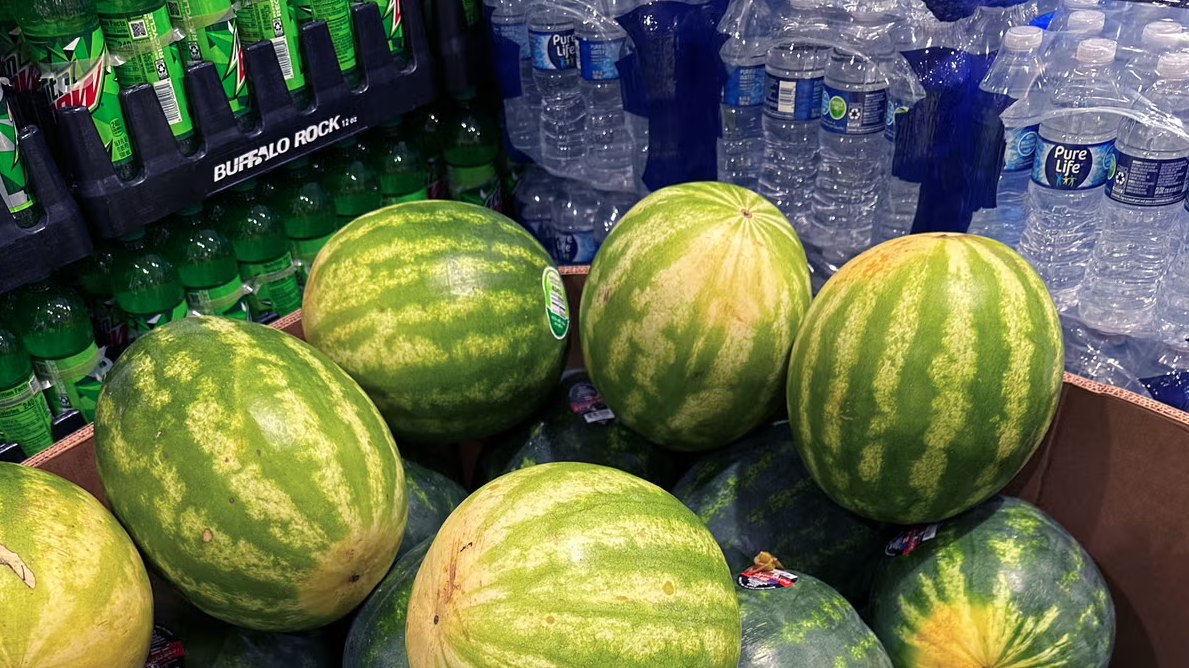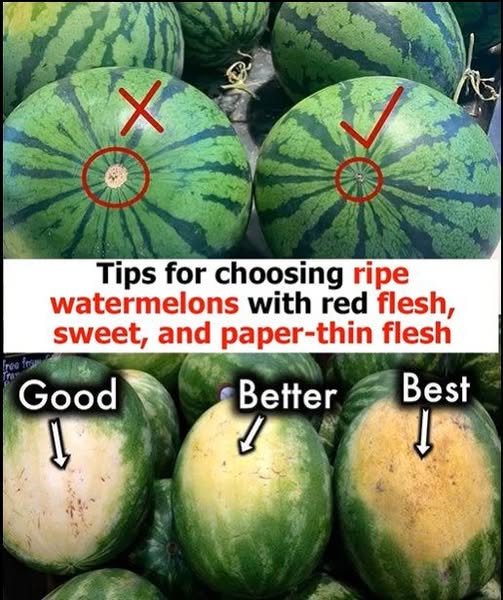Selecting a perfectly ripe watermelon can significantly enhance your enjoyment of this refreshing fruit. To ensure you choose a watermelon with sweet, red flesh and a thin rind, consider the following expert tips.
1. Examine the Field Spot
The field spot, or ground spot, is the area where the watermelon rested on the ground during growth. A creamy yellow or orangey field spot indicates that the melon ripened longer on the vine, leading to increased sweetness. Conversely, a white or absent field spot suggests the fruit may be underripe.
2. Perform the Tap Test
Gently tapping the watermelon can reveal its ripeness. A ripe watermelon produces a deep, hollow sound, indicating juiciness and maturity. A dull or flat sound may signify that the melon is underripe or overripe.

3. Inspect the Webbing
Webbing refers to the brown, web-like veins or scars on the watermelon’s surface. These markings result from pollination and sugar formation. A higher concentration of webbing often correlates with a sweeter melon.
4. Assess the Shape and Weight
Choose a watermelon that has a symmetrical, uniform shape without irregular bumps or dents. Such uniformity indicates consistent growth and ripening. Additionally, the melon should feel heavy for its size, suggesting a high water content and juicy flesh.
5. Observe the Rind’s Appearance
A ripe watermelon typically has a dull, matte rind rather than a shiny one. The dullness indicates full ripeness, while a shiny rind may suggest the fruit is underripe.
6. Smell the Stem End
A ripe watermelon emits a sweet aroma, especially near the stem end. If the melon has little to no scent, it might not be fully ripe. An overly strong smell could indicate overripeness.
7. Consider the Season
Watermelons are typically in season from May to September, with peak ripeness occurring in mid to late summer. Purchasing during this period increases the likelihood of selecting a ripe, flavorful melon.
8. Store Properly After Purchase
Once you’ve selected a ripe watermelon, proper storage is key to maintaining its quality. Keep whole watermelons at room temperature in a cool, dry place away from direct sunlight. After cutting, store the pieces in an airtight container in the refrigerator and consume within five days.
9. Look for Sugar Spots and Pollination Points
Sugar spots are small, darkened areas that look like dried sap or sugar crystals on the surface of the watermelon. These spots are signs that sugar is seeping out of the fruit, indicating a high level of sweetness. Additionally, small black dots or “bee stings” are indicators of strong pollination during growth, which often leads to better flavor development. While these marks might seem unattractive, they’re usually signs of a tasty fruit inside.
10. Check the Tail or Tendril
If you’re buying a watermelon with part of the vine still attached, take a look at the curly tendril near the stem. A dry, brown tendril usually signals that the melon was picked when it was ripe. If the tendril is still green, the fruit may have been harvested too early and could lack full sweetness and flavor. This little detail often goes unnoticed, but it’s a great clue for identifying the ripest melons.
11. Go for Medium-Sized Melons
Bigger isn’t always better. Medium-sized watermelons tend to be juicier and sweeter compared to oversized ones, which may be more watery or bland. Also, smaller melons are often picked younger and may not have developed their full flavor yet. Try to aim for a melon that’s heavy for its size and falls into the medium range—this usually strikes the best balance between taste, texture, and ripeness.
12. Prefer Locally Grown Watermelons
Whenever possible, buy watermelons that are grown locally or regionally. These fruits are more likely to have been harvested at peak ripeness since they don’t need to travel long distances. Imported melons may be picked before they are fully ripe to survive the shipping process, which can affect both taste and texture. Supporting local farms also helps reduce your environmental footprint.

13. Don’t Be Fooled by Color Alone
Many people assume that a bright green watermelon is always the best pick, but color can be misleading. While the color can provide some clues, it shouldn’t be the only factor in your decision. Focus instead on other signs like the field spot, shape, weight, and sound when tapped. Sometimes the ripest, sweetest melons don’t look the most photogenic, so trust the science over appearances.
Final Thoughts: Practice Makes Perfect
Like any fruit, choosing the perfect watermelon takes a bit of practice and experience. Over time, you’ll become more confident in spotting the subtle differences between ripe and underripe melons. Don’t hesitate to test different techniques—some may work better for you than others depending on where and how the melons were grown. Whether you’re planning a summer picnic, making a refreshing smoothie, or simply enjoying it as a healthy snack, selecting a ripe watermelon ensures you get the most out of its flavor and nutritional benefits. Use these tips next time you’re at the market or store, and enjoy the satisfaction of slicing into a perfectly sweet, red-fleshed watermelon with a thin, crisp rind.

















